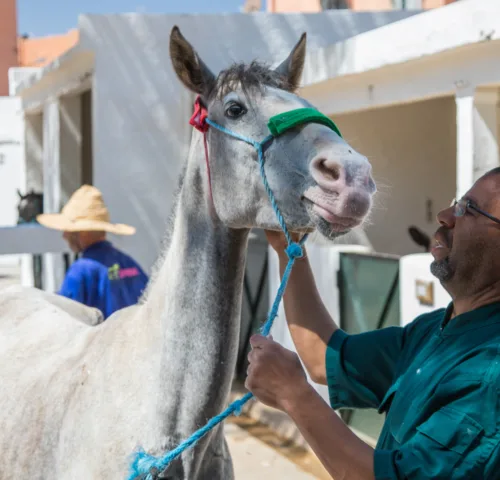Parasites in animals are not uncommon. While it’s not always possible to avoid parasites in the first place, being able to reduce the risk of infection, identify types of parasites – such as animal worms – and treat the infection can help ensure an animal’s continued health and safety.
The effect parasites have on animals (hosts) can vary depending on the parasite’s life cycle and the animal’s general health. It is always best to treat parasites as early as possible to reduce the severity of the disease and the potential for complications, as well as limit the risk of contamination of the environment and allow animals to recover as quickly as possible.
Below, we have put together some of the most common types of parasites that SPANA vets treat when caring for working animals.
Roundworms
Animal worms are one of the most common and commonly known types of parasites in animals. Infection is not limited to wild or working animals, as domestic animals, such as cats and dogs, can also suffer from worms at any stage in their life.
Roundworms in horses, also known as ascarids, are common parasites that live inside a host’s intestines, feeding on partially digested food. Although you may not see notable symptoms in an infected animal, some roundworm symptoms include:
- Weakness
- Diarrhoea
- Weight loss
- Malnutrition
Roundworms can produce tens of thousands of eggs a day and can easily spread between animals. Young animals can get roundworms from their mothers when they are born or drink their milk. However, most of the time, animals become infected because of contaminated pasture.
Preventing and treating roundworms
As roundworms can enter an animal’s body in many ways, it is vital to control environments as much as possible – including removing manure from fields and pastures, limiting the number of animals kept together to reduce contamination and avoiding overgrazing.
Animal worms can typically be treated, so if you have an animal that is infected with roundworms, contact a vet for appropriate treatment methods.
Pinworms
These tiny, narrow intestinal worms affect only a few types of animals, such as equines, rabbits and hamsters. However, unlike some other parasites, pinworms cannot be transmitted between different types of animals.
Animals infected with pinworms usually have quite mild symptoms, and some may not exhibit any whatsoever in some cases. However, the most apparent indication that an animal may have pinworms is itching and irritation around the anal area, as this is where female pinworms deposit eggs. Animals with pinworms may also exhibit weight loss and sleeplessness.
How to treat pinworms
There are two things to consider when treating pinworms in infected animals: the pinworm within the animal’s intestine and the eggs. Anal areas should be cleaned regularly to remove any remaining eggs. At the same time, vets can prescribe oral medication to kill existing adult pinworms, as well as those that have just hatched.
Sarcoptic mange
Sarcoptic mange (scabies) is the medical name for the skin disease caused by infection from a highly contagious skin parasite named Sarcoptes scabiei mite. Compared to infections caused by other parasites, scabies is an infestation of mites that burrow their way into the host’s skin, causing severe itching. This, in turn, can result in scabs and hair loss in animals.
Treatment for sarcoptic mange (scabies)
Although rare, scabies is zoonotic – meaning it’s transmissible between animals and people, so treating it as soon as possible is critical. Symptoms of sarcoptic mange are most seen on the abdomen, elbows and chests of animals, so it can be difficult to diagnose.
Always consult a veterinarian if you suspect an animal may be suffering from an infestation. They will be able to recommend effective therapies for treatment.
Ticks
Ticks are tiny spider-like creatures that suck blood from other animals, dropping off when they have had enough. They typically live in woodland areas or places with long grass and climb or drop on animals when they brush past. Ticks also carry parasites such as babesia – a blood parasite that infects red blood cells causing health issues such as anaemia, jaundice and fever – which they transmit between animals.
How often ticks can affect animals depends on the region/country, the time of year and whether an animal has been treated with any tick control products.
How to remove ticks from animals
Although tick bites rarely cause more than irritation, it’s essential to be vigilant and check animals for ticks regularly. This is because they can pass on infections such as anaplasmosis, Trypanosoma or babesia, and in rare cases, diseases such as Lyme disease. Extra care should be taken with tick removal due to the risk of bacterial infections, as there is a chance that incorrect removal could result in a remnant of the tick being left behind, which may cause infection. For example, it is important to avoid squeezing the tick’s body or leaving the head in the animal that the tick has infected. It’s equally important to avoid harsher methods such as burning them off.
If you are unsure about the best way to remove ticks, speak to a vet who can show you the appropriate method, which involves twisting.
Bots
Bots are flies capable of causing both irritation and physical damage to animals. They lay sticky white or yellow eggs in the hairs of equines, which the animals can then ingest.
Problems caused by bots
Ingested larvae can:
- Impede digestion
- Create loss of appetite
- Cause intermittent diarrhoea or constipation
- Result in stomach ulcers
- Cause perforation of the stomach, in severe cases
Controlling and treating bots
There are special tools designed to facilitate the removal of bot eggs. Washing or wiping off animals can also help remove eggs before they get licked off and ingested by animals grooming themselves or each other. However, removing all the eggs may not always be possible as some can be hidden beneath the animals’ hair.
Vets will also be able to inform you of an appropriate dewormer and how it should be administered, as this can help kill maturing larvae.
Threadworms
Although natural immunity to threadworms usually develops in equines at about six months, infected foals are typically left weak and susceptible to diarrhoea and anaemia. Once adult, threadworms often remain dormant but can be passed to newborns that are suckling.
How to combat threadworms
Treating animal worms such as threadworms before they cause severe problems is crucial for a growing foal’s health. Foals should be wormed against threadworms as early as possible. Worming the mare during pregnancy can also help reduce the chances of transferring threadworms while the animal is nursing. Always consult a vet when considering worming treatments.
At SPANA, our vets work in low-income countries worldwide to provide vital treatment to horses, donkeys and other working animals that otherwise would not be able to access veterinary care. They are also on hand to train owners in how to best look after their animals. Families in the poorest communities often rely completely on their working animals to be able to earn a small income and put food on the table, so protecting their health and welfare is extremely important. You can read more about what we do and support our mission to help working animals across the world by spreading the word and donating to our parasites appeal if you can.


